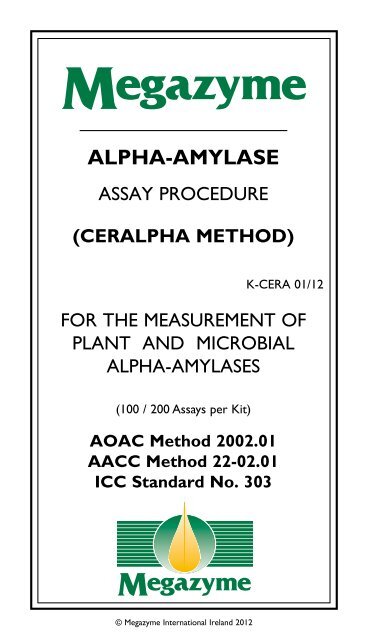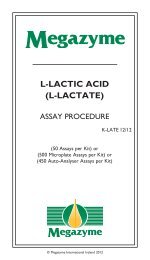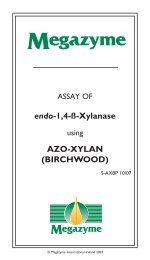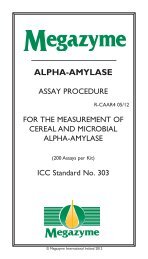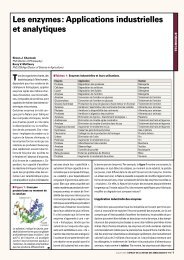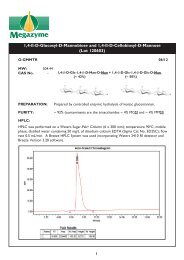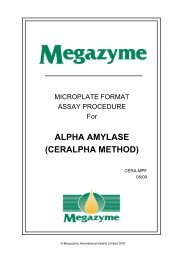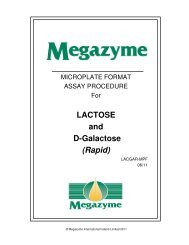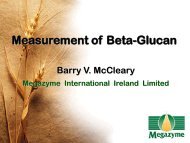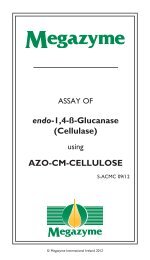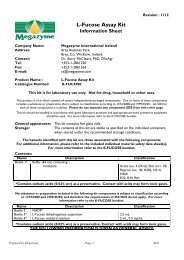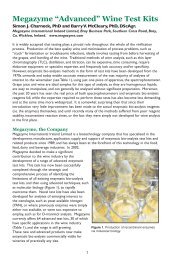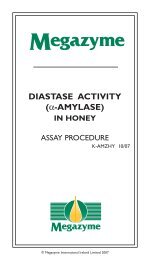ALPHA-AMYLASE - Megazyme
ALPHA-AMYLASE - Megazyme
ALPHA-AMYLASE - Megazyme
You also want an ePaper? Increase the reach of your titles
YUMPU automatically turns print PDFs into web optimized ePapers that Google loves.
<strong>ALPHA</strong>-<strong>AMYLASE</strong><br />
ASSAY PROCEDURE<br />
(CER<strong>ALPHA</strong> METHOD)<br />
K-CERA 01/12<br />
FOR THE MEASUREMENT OF<br />
PLANT AND MICROBIAL<br />
<strong>ALPHA</strong>-<strong>AMYLASE</strong>S<br />
(100 / 200 Assays per Kit)<br />
AOAC Method 2002.01<br />
AACC Method 22-02.01<br />
ICC Standard No. 303<br />
© <strong>Megazyme</strong> International Ireland 2012
INTRODUCTION:<br />
Microbial α-amylases find widespread application in the modification<br />
of starch in cereal products and in cereal processing. The level of<br />
endogeneous α-amylase in cereal grains and products significantly<br />
affects the industrial exploitation of these commodities. In breadmaking,<br />
the level of α-amylase must be sufficient to produce<br />
saccharides which can be absorbed and utilised by yeast, but not<br />
so high as to cause excessive starch dextrinisation, which can lead<br />
to sticky crumb and problems in processing. In the brewing industry,<br />
the level of malt α-amylase is a key quality parameter. α-Amylase<br />
also finds application as a silage additive, to assist in the degradation<br />
of starch and thus to provide fermentable sugars for bacterial growth.<br />
Bacterial, fungal and cereal α-amylases can all be measured with<br />
Amylase HR reagent, however, assay conditions (specifically pH) need<br />
to be modified to suit each particular enzyme. Amylase HR Reagent<br />
is specific for α-amylase. The substrate is absolutely resistant to<br />
hydrolysis by exo-enzymes such as β-amylase, amyloglucosidase and<br />
α-glucosidase.<br />
PRINCIPLE:<br />
The Ceralpha procedure (employing Amylase HR reagent) for the<br />
assay of α-amylase employs, as substrate, the defined oligosaccharide<br />
“non-reducing-end blocked p-nitrophenyl maltoheptaoside” (BPNPG7)<br />
in the presence of excess levels of a thermostable α-glucosidase<br />
(which has no action on the native substrate due to the presence of<br />
the “blocking group”). On hydrolysis of the oligosaccharide by endoacting<br />
α-amylase, the excess quantities of α-glucosidase present in<br />
the mixture give instantaneous and quantitative hydrolysis of the<br />
p-nitrophenyl maltosaccharide fragment to glucose and free<br />
p-nitrophenol. The assay format is shown in Scheme 1 (page 17)<br />
and the linearity of the assay is shown in Figure 1 (page 11).<br />
Essentially, an aliquot of a cereal flour extract or fermentation broth<br />
is incubated with substrate mixture under defined conditions, and<br />
the reaction is terminated (and colour developed) by the addition of<br />
a weak alkaline solution. The absorbance at 400 nm is measured<br />
(previously, absorbance values were measured at 410 nm in line with<br />
literature values, however, the true absorption peak is at 400 nm)<br />
(see Figure 4, page 12) and this relates directly to the level of<br />
α-amylase in the sample analysed.<br />
Amylase HR Reagent mixture can be used to quantitatively assay<br />
cereal, fungal and bacterial α-amylases. With the replacement of<br />
amyloglucosidase and yeast α-glucosidase (as present in the original<br />
Ceralpha Reagent mixture) by thermostable α-glucosidase, the assay<br />
1
can now be used over a broader pH range (5.2 to 7.0) and at<br />
temperatures of up to 60°C. With this new reagent, the optimal<br />
pH for activity of cereal α-amylases is 5.2-5.4 (see Figure 7, Page 16).<br />
Furthermore, in this pH range, the activity values obtained for cereal<br />
α-amylases with Amylase HR reagent, are essentially the same as<br />
those obtained with Ceralpha reagent (containing amyloglucosidase<br />
and α-glucosidase) at pH 5.2. Reagent mixtures employing blocked<br />
p-nitrophenyl maltoheptaoside as substrate do not distinguish<br />
between fungal, cereal and bacterial α-amylases.<br />
ACCURACY:<br />
Standard errors of less than 5% are achieved routinely.<br />
KITS:<br />
Kits suitable for performing 100/200 assays are available from<br />
<strong>Megazyme</strong>, and consist of:-<br />
1. Full assay method<br />
2. Freeze dried BPNPG7 plus thermostable α-glucosidase<br />
3. Concentrated Extraction Buffer<br />
4. Concentrated Stopping Reagent<br />
5. Control Malt Flour<br />
SPECIFICITY:<br />
The assay is absolutely specific for α-amylase.<br />
Table 1: Reproducibility of the Ceralpha assay for the<br />
measurement of wheat-flour α-amylase a<br />
Absorbance (400 nm)<br />
Sample Day 1 Day 2 Day 3 Day 4 Average<br />
A 0.365 0.390 0.365 0.354 0.384 0.379 0.385 0.398 0.378<br />
B 0.486 0.534 0.463 0.502 0.502 0.507 0.514 0.486 0.499<br />
C 0.255 0.259 0.270 0.286 0.265 0.287 0.264 0.284 0.271<br />
D 0.142 0.146 0.143 0.150 0.142 0.137 0.135 0.153 0.143<br />
S.E.M. b 0.0134 0.0134 0.0134 0.0134 0.0067<br />
a Duplicate analyses of single extracts made on four separate days.<br />
b Based on a pooled estimate of the variance for each sample mean.<br />
s.d. of single observation (for comparisons on same and different days) = 0.0189.<br />
c.v. (%) = 4.05.<br />
2
ENCLOSED SUBSTRATE:<br />
Blocked p-nitrophenyl maltoheptaoside (BPNPG7, 54.5 mg)<br />
Thermostable α-glucosidase (125 U at pH 6.0), per vial.<br />
Dissolve the entire contents of one vial in 10.0 mL of distilled water.<br />
Divide into 2-3 mL aliquots and store frozen between use. At 0-5°C the<br />
dissolved substrate is stable for seven days; in the frozen state it is stable<br />
for at least 12 months.<br />
ENCLOSED MALT FLOUR:<br />
Malt flour of standardised α-amylase activity (as specified on the vial<br />
label). It is recommended that the user standardises at least one batch<br />
of user’s own wheat or malt flour to be employed as a secondary<br />
reference flour.<br />
ENCLOSED SOLUTIONS:<br />
(1) Concentrated Extraction Buffer: 1 M sodium malate<br />
(Buffer A) 1 M sodium chloride<br />
40 mM calcium chloride<br />
0.1% sodium azide<br />
Dilute the entire contents (50 mL) (plus a crystalline precipitate which<br />
may be present) to 1000 mL with distilled water before use. Stable at<br />
0-5°C for 12 months. The pH should be 5.4; adjust if necessary.<br />
(2) Concentrated Stopping Reagent: (20% [w/v] tri-sodium<br />
phosphate solution, pH ~11)<br />
Dilute the entire contents (25 mL) to 500 mL with distilled water. Stable<br />
at room temperature for three months.<br />
PREPARATION OF ADDITIONAL EXTRACTION BUFFERS:<br />
A. Buffer A (for cereal and fungal α−amylase):<br />
Malic acid (Sigma M-0875; 1 M) 134.1 grams/litre<br />
Sodium hydroxide 70 grams/litre<br />
Sodium chloride 58.4 grams/litre<br />
Calcium chloride dihydrate (40 mM) 5.9 grams/litre<br />
Sodium azide (Sigma S2002; 0.1%) 1.0 grams/litre<br />
Add malic acid, sodium chloride and sodium hydroxide to 800 mL<br />
of distilled water, allow to cool to room temperature and add the<br />
calcium chloride. Adjust the pH to 5.4 by dropwise addition of sodium<br />
hydroxide (4 M) or HCl (4 M). Then add the sodium azide. Adjust<br />
volume to 1 litre. Store at room temperature. For use, dilute 50 mL<br />
of this concentrated buffer solution to 1 litre with dist. water.<br />
3
CAUTION<br />
Dissolve the reagents and adjust the pH to 5.4 before adding the<br />
sodium azide. Adding sodium azide to an acidic solution results in<br />
the release of a poisonous gas.<br />
Powdered malic and maleic acids are irritants, and thus should be<br />
handled with due care.<br />
B. Buffer B (for Bacillus sp. α-amylase):<br />
Maleic acid (Sigma M-0375; 0.1 M)<br />
Sodium chloride<br />
Calcium chloride dihydrate (2 mM)<br />
Sodium azide (Sigma S-2002; 0.01% w/v)<br />
23.2 grams/2 litres<br />
11.6 grams/2 litres<br />
0.6 grams/2 litres<br />
0.2 grams/2 litres<br />
Add the maleic acid and sodium chloride to 1600 mL of distilled<br />
water and adjust the pH to 6.5 with 4 M (160 g/litre) sodium hydroxide.<br />
Add the calcium chloride and sodium azide and adjust the volume<br />
to 2 litres. Store at room temperature between use.<br />
Use this buffer directly without further dilution.<br />
Some bacterial α-amylases are unstable on dilution. This problem is<br />
usually resolved by inclusion of BSA (0.5 mg/mL) in the buffer.<br />
PREPARATION OF ADDITIONAL STOPPING REAGENT:<br />
Dissolve 10 g of tri-sodium phosphate (anhydrous) in 1 litre of distilled<br />
water and adjust the pH to approx. 11.0. Stable at room temperature<br />
for at least three months.<br />
EQUIPMENT (RECOMMENDED):<br />
1. Glass test tubes (12 mL and 20 mL capacity).<br />
2. Pipettors, 0.1 and/or 0.2 mL (e.g. Gilson Pipetman ® )<br />
to dispense enzyme extract and substrate.<br />
3. Adjustable-volume dispenser:<br />
- 0-10 mL (for Extraction Buffer)<br />
- 0-5 mL (for Stopping Reagent).<br />
4. Positive displacement pipettor e.g. Eppendorf Multipette ®<br />
- with 5.0 mL Combitip ® (to dispense 0.5 mL aliquots<br />
of concentrated enzyme solutions), and<br />
- with 25 mL Combitip ®<br />
(to dispense various aliquots of dilution buffers).<br />
4
5. Top-pan balance.<br />
6. Spectrophotometer set at 400 nm.<br />
7. Vortex mixer (optional).<br />
8. Thermostated water bath set at 40°C.<br />
9. Stop Clock.<br />
10. Bench centrifuge or Whatman GF/A glass fibre filter paper circles<br />
(9 cm diameter).<br />
CONTROLS AND PRECAUTIONS:<br />
1. α-Amylase is an enzyme present at high levels in all body fluids.<br />
It is thus recommended that disposable gloves are used when<br />
handling and dispensing the substrate mixture.<br />
2. It is essential that the water used to dissolve the Ceralpha<br />
substrate mixture is high purity. If freshly distilled water is not<br />
available, heat the water to boiling and cool it to less than 30°C<br />
before using. Algal growth in water in wash bottles can produce<br />
sufficient α-amylase to significantly reduce the long-term stability<br />
of the reagent dissolved in such water.<br />
3. The freeze-dried substrate is extremely stable at room<br />
temperature, however, when dissolved it should be stored at<br />
0-5°C during use and at -20°C between use. If the number of<br />
assays performed at any one time is limited, it is recommended<br />
that the substrate be divided into 2-3 mL aliquots and stored in<br />
the frozen state.<br />
4. On storage at 0-5°C, the blank absorbance values will increase<br />
from 0.03 to about 0.05 in 5 days, this does not affect the<br />
performance of the substrate, but obviously these values must<br />
be determined at the same time as the assay is performed. Blank<br />
absorbance values as high as 0.50 do not affect the reliability or<br />
accuracy of the assay.<br />
NOTE:<br />
A single Reaction Blank only is normally sufficient for each batch<br />
of samples being analysed. To obtain this blank value, 3.0 mL<br />
of stopping reagent should be added to 0.2 mL of substrate<br />
solution. Then add 0.2 mL of enzyme preparation.<br />
5
5. The spectrophotometer employed should be standardised with<br />
a p-nitrophenol standard in 1% tri-sodium phosphate (E mM =<br />
18.1). p-Nitrophenol solution (10 mM) can be obtained from<br />
Sigma Chemical Company (cat no. N-7660). An aliquot of this<br />
solution when diluted 200-fold in 1% tri-sodium phosphate gives<br />
an absorbance of 0.905 at 400 nm.<br />
6. The assay format should be standardised with the enclosed malt<br />
flour. The activity of this flour is shown on the enclosed vial.<br />
A wheat flour standard can be provided on request.<br />
7. The time of extraction of wheat flours should be carefully<br />
controlled (15-20 min). With malt flour samples, the optimal<br />
extraction time is also 15-20 min.<br />
USEFUL HINTS:<br />
1. If the absorbance values for a particular assay are greater than<br />
1.20, the enzyme extract should be diluted with the appropriate<br />
buffer and re-assayed.<br />
2. The number of assays which can be performed per kit can be<br />
doubled by halving the volumes of all reagents used and employing<br />
semi-micro spectrophotometer cuvettes.<br />
ENZYME EXTRACTION:<br />
A. Wheat and Barley Flours:<br />
1. Mill wheat, barley or other grain (approximately 10-50 g sample)<br />
to pass a 0.5 mm screen (e.g. with a Fritsch centrifugal mill).<br />
2. Accurately weigh 3.0 g of flour into a flask of 50 mL capacity.<br />
3. To each flask add 20.0 mL of Extraction Buffer solution (pH 5.4)<br />
and stir the flask contents vigorously.<br />
4. Allow the enzyme to extract over 15-20 min at 40°C, with<br />
occasional mixing.<br />
5. Filter an aliquot of the solution through a Whatman GF/A glass<br />
fibre filter paper, or centrifuge an aliquot at 1,000 g for ten<br />
minutes. Assay enzyme activity within two hours.<br />
NOTE:<br />
The control wheat flour from <strong>Megazyme</strong> is very homogeneous.<br />
Consequently, a smaller sample weight can be extracted (e.g. 1.0 g<br />
per 6.0 mL of extraction buffer.<br />
6
B. Malt Flours:<br />
1. Mill malt (20 g sample) to pass a 0.5 mm screen.<br />
2. Accurately weigh 0.5 g malt flour into a 100 mL volumetric flask.<br />
3. To the volumetric flask add a solution of 1% sodium chloride plus<br />
0.02% calcium chloride plus 0.02% sodium azide; adjust to volume.<br />
4. Allow the enzyme to extract for 15-20 min at room temperature,<br />
with occasional stirring.<br />
5. Filter an aliquot of the solution through a Whatman GF/A glass<br />
fibre filter paper, or centrifuge at 1,000 g for ten minutes.<br />
6. Dilute 0.5 mL of the filtrate with 9.5 mL of Extraction Buffer<br />
Solution. Assay activity within two hours.<br />
C. Microbial Preparations:<br />
Liquid preparations:<br />
1. Add 1 mL of liquid enzyme preparation (using a positive<br />
displacement dispenser) to Buffer A or B (49 mL, pH 5.4 or<br />
6.5) and mix thoroughly. This is termed the Original Extract.<br />
2. Dilute 1.0 mL of original extract 10-fold by addition to 9.0 mL<br />
of appropriate Buffer (A or B) and mix thoroughly. Repeat this<br />
step until a dilution suitable for assay is obtained.<br />
For example, for the industrial enzyme preparation, Bacterial<br />
Alpha-Amylase (from Kerry Ingredients, Ireland) a dilution of the<br />
original extract of approximately 4,000-fold is required.<br />
Powder preparations:<br />
1. Add 1 g of enzyme powder preparation to 50 mL of Buffer<br />
A or B (pH 5.4 or 6.5) and gently stir the slurry over a period<br />
of about 15 min or until the sample is completely dispersed or<br />
dissolved.<br />
2. Clarify this solution (the Original Extract) by centrifugation<br />
(1,000 g, 10 min) or filtration through Whatman No. 1 (9 cm)<br />
filter circles.<br />
3. Dilute 1.0 mL of this solution 10-fold by addition to 9.0 mL of<br />
appropriate extraction/ dilution buffer and mix thoroughly.<br />
Repeat this step until a dilution suitable for assay is obtained.<br />
7
ASSAY PROCEDURE:<br />
A. Wheat and barley flours:<br />
1. Dispense 0.2 mL aliquots of Amylase HR Reagent Solution<br />
(unbuffered) into test tubes and pre-incubate the tubes and<br />
contents at 40°C for 5 min.<br />
2. Pre-incubate cereal extract at 40°C for 5 min.<br />
3. To each tube containing Amylase HR Reagent solution<br />
(0.2 mL), add 0.2 mL of pre-equilibrated wheat or barley extract<br />
directly to the bottom of the tube. Incubate at 40°C for exactly<br />
twenty (20) min (from time of addition).<br />
4. At the end of the 20 min incubation period, add exactly 3.0 mL<br />
of Stopping Reagent and stir the tube contents vigorously.<br />
5. Read the absorbance of the solutions and the reaction blank<br />
at 400 nm against distilled water.<br />
B. Malt and microbial preparations:<br />
1. Dispense 0.2 mL aliquots of Amylase HR Reagent solution<br />
(unbuffered) into test tubes and pre-incubate the tubes and<br />
contents at 40°C for 5 min.<br />
2. Pre-incubate buffered malt or microbial preparation extract at<br />
40°C for 5 min.<br />
3. To each tube containing Amylase HR Reagent Solution<br />
(0.2 mL), add 0.2 mL of pre-equilibrated (and suitably diluted)<br />
microbial enzyme or malt extract directly to the bottom of<br />
the tube. Incubate at 40°C for exactly 10 min (from time of<br />
addition).<br />
4. At the end of the 10 min incubation period, add exactly 3.0 mL<br />
of Stopping Reagent and stir the tube contents vigorously.<br />
5. Read the absorbance of the solutions and the reaction blank<br />
at 400 nm against distilled water.<br />
8
CALCULATION OF ACTIVITY:<br />
One Unit of activity is defined as the amount of enzyme, in the<br />
presence of excess thermostable α-glucosidase, required to release<br />
one micromole of p-nitrophenol from BPNPG7 in one minute under<br />
the defined assay conditions, and is termed a Ceralpha Unit.<br />
Units/g Flour:<br />
= ΔE 400 x Total Volume in Cell x 1 x Extraction Vol. x Dilution<br />
Incubation Aliquot Assayed E mM Sample Weight<br />
Time<br />
where:<br />
ΔE 400 = Absorbance (reaction) - Absorbance (blank)<br />
Incubation Time = 10 min (malt and microbial preparation extracts)<br />
= 20 min (wheat and barley extracts)<br />
Total Volume in Cell = 3.4 mL<br />
Aliquot Assayed = 0.2 mL<br />
E mM of p-nitrophenol (at 400 nm) in 1% tri-sodium phosphate = 18.1<br />
Extraction volume = 20 mL per 3 gram (wheat and barley)<br />
100 mL per 0.5 gram (malt)<br />
50 mL per 1 g or 1 mL of microbial preparation.<br />
Dilution = Dilution of the original extract<br />
(= 20-fold for malt extracts).<br />
Thus:<br />
A. For Wheat and Barley:<br />
Units (CU)/g flour:<br />
= ΔE 400 x 3.4 x 1 x 20<br />
20 0.2 18.1 3.0<br />
= ∆ΔE 400 x 0.313<br />
9
B. For Malt:<br />
Units (CU)/gram of milled malt:<br />
= ΔE 400 x 3.4 x 1 x 100 x 20<br />
10 0.2 18.1 0.5<br />
= ΔE 400 x 376<br />
C. For microbial preparations:<br />
Units (CU)/mL or gram of original preparation:<br />
= ΔE 400 x 3.4 x 1 x 50 x Dilution<br />
10 0.2 18.1 1.0<br />
= ΔE 400<br />
x 4.7 x Dilution<br />
where:<br />
ΔE 400 = Absorbance (reaction) - Absorbance (blank)<br />
Incubation Time = 10 min<br />
Total volume in cell = 3.4 mL<br />
Aliquot Assayed = 0.2 mL<br />
E mM of p-nitrophenol (at 400 nm) in 1% tri-sodium phosphate = 18.1<br />
Extraction vol = 50 mL/1.0 g (or 49 mL plus 1 mL of enzyme<br />
concentrate).<br />
Dilution = further dilution of the Original Extract.<br />
10
APPENDIX:<br />
A. Linearity of Ceralpha assay with enzyme<br />
concentration and incubation time.<br />
Absorbance, 410 nm<br />
4 x<br />
3 x<br />
2 x<br />
1 x<br />
Figure 1. Linearity of the Ceralpha assay with malt α-amylase in<br />
sodium malate buffer (pH 5.4). The assay was performed with four<br />
concentrations of enzyme (1x, 2x, 3x and 4x). Reaction was terminated at<br />
various times by adding tri-sodium phosphate (3.0 mL, 1% w/v).<br />
B. Effect of the concentration of thermostable<br />
α-glucosidase in the reagent solution on<br />
determined α-amylase values.<br />
From the results shown in Figure 2, it is evident that the<br />
concentration of α-glucosidase required to saturate the reaction is<br />
12 Units/mL in the substrate solution.<br />
Absorbance, 400 nm<br />
Concentration of α-Glucosidase, U/ml of reagent<br />
Figure 2. The effect of the concentration of α-glucosidase in the<br />
substrate reagent solution on the determined absorbance values.<br />
11
C. Stability of reagent mixture at 60°C.<br />
The stability of the reagent solution was determined by incubating<br />
aliquots of this solution at 60°C for 0-20 min. These solutions were<br />
then used to assay the activity of fungal α-amylase (at 40°C). From<br />
the data shown in Figure 3, it is evident that the reagent is very stable<br />
at 60°C. Over a 20 min incubation period, blank absorbance values<br />
increased by less than 0.01 absorbance units, and the determined<br />
activity decreased by less than 3% (of the non pre-incubated reagent).<br />
Absorbance, 410 nm<br />
Figure 3. Temperature stability of Amylase HR assay reagent.<br />
Aliquots of the reagent were stored at 60°C for 0-20 min, cooled to room<br />
temperature, and used to assay fungal α-amylase at 40°C.<br />
1.00<br />
0.80<br />
1<br />
2<br />
Absorbance<br />
0.60<br />
0.40<br />
0.20<br />
0.00<br />
300 350 400 450 500<br />
Wavelength, nm<br />
Figure 4. Absorbance curve for p-nitrophenol in 1% tri-sodium<br />
phosphate at pH 11.0<br />
12
D. Conversion of Ceralpha Units (CU)<br />
to International Units (IU) on Starch Substrate.<br />
The activity of pure Bacillus subtilis, Aspergillus niger and barley<br />
malt α-amylases on Amylase HR Reagent and on ACS soluble<br />
starch (1% w/v; assayed using the Nelson-Somogyi reducing sugar<br />
procedure; International Units) were determined and the conversion<br />
factors are:<br />
A. niger (both assays performed at pH 5.4)<br />
International Units on Starch = 0.94 x Ceralpha Units.<br />
B. subtilis (both assays performed at pH 6.5)<br />
International Units on Starch = 4.6 x Ceralpha Units.<br />
Barley malt (both assays performed at pH 5.4)<br />
International Units on Starch = 4.1 x Ceralpha Units.<br />
One International Unit (IU) of activity is defined as the amount<br />
of enzyme required to release one micromole of glucose<br />
reducing-sugar equivalents per minute under defined conditions of<br />
temperature and pH.<br />
E. Comparison of the Ceralpha and Farrand Methods for<br />
the Measurement of Wheat and Fungal α-Amylase.<br />
The Farrand method employs a β-limit dextrin of starch as substrate,<br />
and measures the decrease in the colour of the starch/iodine complex<br />
on depolymerisation of the substrate. The assay is performed in the<br />
presence of excess quantities of β-amylase, which for cereal samples,<br />
originate from the flour extract. For fungal samples, a pure β-amylase<br />
has to be added. The Farrand method was commonly used in the<br />
United Kingdom and employed a β-limit dextrin preparation supplied<br />
by Rank Hovis. [A purified β-limit dextrin (maltose removed) is now<br />
available from <strong>Megazyme</strong> International].<br />
In the standard Farrand method, the extract is unbuffered and the pH<br />
of the flour extracts is approx. 5.8. In an interlaboratory comparison<br />
of the Farrand and Ceralpha methods, coordinated by Campden-<br />
Chorleywood Food Research Association, the correlation between<br />
Farrand and Ceralpha Units for wheat flour α-amylase was found to<br />
be:<br />
Farrand Units = Ceralpha Units x 57 - 1.9<br />
13
A very similar correlation for wheat α-amylase was previously<br />
reported by McCleary and Sheehan (1987), namely:<br />
Farrand Units = Ceralpha Units x 57.1<br />
For fungal preparations, the regression equation obtained by<br />
McCleary et al. was:<br />
Farrand Units = Ceralpha Units x 69<br />
The measurement of α-amylase in wheat flour supplemented with<br />
fungal α-amylase is complicated by the problems associated with the<br />
blending of two components, one of which has a low level of enzyme,<br />
and the other of which has a level several thousand-fold higher than<br />
the first component. To try to minimise the errors associated with<br />
possible incomplete mixing of these components, duplicate samples<br />
should be assayed, and larger samples should be extracted<br />
(~ 6 g/40 mL).<br />
F. Comparison of the Ceralpha Method (CU),<br />
the ASBC Method (DU) and AACC Method 22-01<br />
(SKB Units) for the Measurement of α-Amylase:<br />
AACC method 22-01 (SKB Units) uses a β-limit dextrin prepared<br />
from a “special” lintner starch supplied by AACC/ASBC. The method<br />
measures the time to reach a particular colour with iodine, on<br />
incubation of α-amylase with the β-limit dextrin at 30°C.<br />
The ASBC/EBC/International Method (Dextrinising Units, DU)<br />
uses the same substrate and the same concentration of enzyme as<br />
employed in AACC Method 22-01, and the Units of activity are<br />
calculated the same way. However, since the assay is performed at<br />
20°C, DU values for a particular malt sample are approximately<br />
half the SKB value for the same malt.<br />
The correlation between AACC Method 22-01 (SKB Units) and<br />
Ceralpha Units (CU) for malt flours is shown in Figure 5. The<br />
correlation between the ASBC (International Method) for α-amylase<br />
(DU) and the Ceralpha method (CU) is shown in Figure 6.<br />
14
AACC Method 22-01 (SKB Units /gram)<br />
160<br />
140<br />
120<br />
100<br />
80<br />
60<br />
40<br />
20<br />
0<br />
SKB Units = 0.42 x Ceralpha Units - 0.34<br />
0 100 200 300 400<br />
Ceralpha Units/gram<br />
Figure 5. Comparison of the Ceralpha method and AACC Method<br />
22-01 (SKB) for the measurement of α-amylase in malt flours.<br />
Seven malt samples were analysed in duplicate by the two methods.<br />
ASBC Method (Dextrinising Units /gram)<br />
DU = 0.23 x Ceralpha Units + 0.61<br />
Ceralpha Units/gram<br />
Figure 6. Comparison of the Ceralpha and the ASBC (International)<br />
methods for the measurement of α-amylase in malt flours.<br />
Seven malt samples were analysed in duplicate by the two methods.<br />
15
The conversion factors relating SKB Units to Ceralpha Units<br />
for malt, fungal and bacterial α-amylases are:<br />
Malt α-amylase:<br />
SKB Units = 0.42 x Ceralpha Units (CU) - 0.34.<br />
(SKB performed at pH 4.7; Ceralpha performed at pH 5.4).<br />
Fungal α-amylase:<br />
SKB Units = 0.60 x Ceralpha Units (CU).<br />
(SKB performed at pH 5.4; Ceralpha performed at pH 5.4).<br />
Bacterial α-amylase:<br />
SKB Units = 1.8 x Ceralpha Units (CU).<br />
(SKB performed at pH 6.5; Ceralpha performed at pH 6.5).<br />
G. pH Activity Curves for Cereal, Fungal and Bacterial<br />
α-Amylases.<br />
pH Activity curves for malted wheat, malted barley, fungal (A. niger)<br />
and bacterial (B. subtilis) α-amylases were determined using the<br />
Ceralpha method with Amylase HR Reagent. For cereal and fungal<br />
α-amylases, the pH curve was prepared using malate and maleate<br />
buffers (100 mM, pH 5.0-6.4); for bacterial α-amylase, maleate and<br />
Bis-Tris Propane buffers were employed (pH 5.6-9.0). All buffers<br />
contained 10 mM calcium chloride. The curves for purified malted<br />
wheat and fungal α-amylases are shown in Figure 7. Malted barley<br />
α-amylases gave the same curve as malted wheat. The pH activity<br />
curve for B. subtilis α-amylase is shown in Figure 8.<br />
Absorbance, 400 nm<br />
Figure 7. pH activity curves for fungal (A.niger) and malted wheat<br />
α-amylases. Fungal α-amylase was assayed with both Amylase HR Reagent<br />
and Cereal α-Amylase assay reagent (containing amyloglucosidase and yeast<br />
α-glucosidase). The curves with the two reagents were the same.<br />
16
Absorbance, 410 nm<br />
Figure 8. pH activity curves for B. subtilis α-amylase.<br />
Blocked p-nitrophenyl maltoheptaoside (BPNPG7)<br />
α-Amylase<br />
Blocked maltosaccharide<br />
p-nitrophenyl maltosaccharide<br />
Thermostable<br />
α-glucosidase<br />
Reaction Stopped and<br />
yellow colour developed<br />
tri-Sodium Phosphate<br />
(pH ~ 11.0)<br />
Scheme 1. Theoretical basis of the Ceralpha α-amylase assay<br />
procedure. Immediately α-amylase cleaves a bond within the blocked<br />
p-nitrophenyl maltosaccharide substrate, the non-blocked reaction product<br />
containing the p-nitrophenyl substituent is instantly cleaved to glucose and<br />
free p-nitrophenol by the excess quantities of thermostable α-glucosidase<br />
which is an integral part of the substrate mixture, and free p-nitrophenol is<br />
released. The reaction is terminated and the phenolate colour is developed<br />
on addition of tri-sodium phosphate (pH ~ 11.0).<br />
17
NOTES<br />
REFERENCES:<br />
1. McCleary, B. V. & Sheehan, H. (1987). Measurement of<br />
Cereal α-Amylase: A New Assay Procedure. Journal of<br />
Cereal Science, 6, 237-251.<br />
2. Sheehan, H. & McCleary, B. V. (1988). A New Procedure<br />
for the Measurement of Fungal and Bacterial α−Amylase.<br />
Biotechnology Techniques, 2, 289-292.<br />
3. McCleary, B. V., McNally, M., Monaghan, D. & Mugford,<br />
D. C. (2002). Measurement of α-amylase activity in<br />
white wheat flour, milled malt, and microbial enzyme<br />
preparations using the Ceralpha Assay collaborative study.<br />
J. AOAC International, 85, 1096-1102.<br />
18
<strong>Megazyme</strong> International Ireland,<br />
Bray Business Park, Bray,<br />
Co. Wicklow,<br />
IRELAND.<br />
Telephone: (353.1) 286 1220<br />
Facsimile: (353.1) 286 1264<br />
Internet: www.megazyme.com<br />
E-Mail: info@megazyme.com<br />
WITHOUT GUARANTEE<br />
The information contained in this booklet is, to the best of our knowledge, true and accurate, but<br />
since the conditions of use are beyond our control, no warranty is given or is implied in respect of<br />
any recommendation or suggestions which may be made or that any use will not infringe any patents.<br />
19


